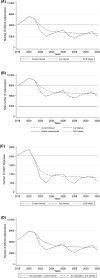Introducing human papillomavirus (HPV) primary testing in the age of HPV vaccination: projected impact on colposcopy services in Wales
- PMID: 33247993
- PMCID: PMC8246959
- DOI: 10.1111/1471-0528.16610
Introducing human papillomavirus (HPV) primary testing in the age of HPV vaccination: projected impact on colposcopy services in Wales
Abstract
Objective: To determine the demand for colposcopy in the Cervical Screening Wales programme after the introduction of human papillomavirus (HPV) cervical screening, which coincided with the start of screening of women vaccinated against HPV types 16/18.
Design: The study used a computational model that assigns screening and screening-related colposcopy events to birth cohorts in individual calendar years.
Setting: Cervical Screening Wales.
Population: Women aged 25-64 years from birth cohorts 1953-2007.
Methods and main outcome measures: We estimated the numbers of colposcopies and high-grade cervical intraepithelial lesions (CIN2+) within Cervical Screening Wales in 2018-32, using official population projections for Wales and published estimates of the effects of HPV screening and vaccination.
Results: Vaccination will reduce the number of colposcopies by 10% within the first 3-4 years after the national roll-out of HPV screening, and by about 20% thereafter. The number of screening colposcopies is estimated to increase from 6100 in 2018 and peak at 8000 (+31%) in 2021, assuming current screening intervals are maintained. The numbers of CIN2+ lesions follow similar patterns, stabilising at around 1000 diagnoses per year by 2026, approximately 60% lower than at present. Extending the screening intervals to 5 years for all women shows similar trends but introduces peaks and troughs over the years.
Conclusions: Vaccination will not fully prevent an increase in colposcopies and detected CIN2+ lesions during the first 2-3 years of HPV-based screening but the numbers are expected to decrease substantially after 5-6 years.
Tweetable abstract: HPV-based cervical screening will initially increase colposcopy referral. In 6 years, this increase will be reversed, partly by HPV vaccination.
Keywords: Cervical screening; colposcopy; human papillomavirus; human papillomavirus vaccination; workload.
© 2020 The Authors. BJOG: An International Journal of Obstetrics and Gynaecology published by John Wiley & Sons Ltd.
Figures


Similar articles
-
The clinical effectiveness and cost-effectiveness of primary human papillomavirus cervical screening in England: extended follow-up of the ARTISTIC randomised trial cohort through three screening rounds.Health Technol Assess. 2014 Apr;18(23):1-196. doi: 10.3310/hta18230. Health Technol Assess. 2014. PMID: 24762804 Free PMC article. Clinical Trial.
-
Cervical screening with primary HPV testing or cytology in a population of women in which those aged 33 years or younger had previously been offered HPV vaccination: Results of the Compass pilot randomised trial.PLoS Med. 2017 Sep 19;14(9):e1002388. doi: 10.1371/journal.pmed.1002388. eCollection 2017 Sep. PLoS Med. 2017. PMID: 28926579 Free PMC article. Clinical Trial.
-
The impact of human papillomavirus type on colposcopy performance in women offered HPV immunisation in a catch-up vaccine programme: a two-centre observational study.BJOG. 2017 Aug;124(9):1394-1401. doi: 10.1111/1471-0528.14563. Epub 2017 Mar 9. BJOG. 2017. PMID: 28102931
-
What's next? Perspectives and future needs of cervical screening in Europe in the era of molecular testing and vaccination.Eur J Cancer. 2009 Oct;45(15):2714-21. doi: 10.1016/j.ejca.2009.07.024. Epub 2009 Aug 18. Eur J Cancer. 2009. PMID: 19695870 Review.
-
Population-level impact and herd effects following the introduction of human papillomavirus vaccination programmes: updated systematic review and meta-analysis.Lancet. 2019 Aug 10;394(10197):497-509. doi: 10.1016/S0140-6736(19)30298-3. Epub 2019 Jun 26. Lancet. 2019. PMID: 31255301 Free PMC article.
Cited by
-
Screening outcome of HPV-vaccinated women: Data from the Danish Trial23 cohort study.PLoS One. 2024 Jun 25;19(6):e0306044. doi: 10.1371/journal.pone.0306044. eCollection 2024. PLoS One. 2024. PMID: 38917143 Free PMC article.
-
Shift in harms and benefits of cervical cancer screening in the era of HPV screening and vaccination: a modelling study.BJOG. 2022 Oct;129(11):1862-1869. doi: 10.1111/1471-0528.17190. Epub 2022 May 6. BJOG. 2022. PMID: 35429107 Free PMC article.
-
Managing an extension of screening intervals: Avoiding boom and bust in health care workloads.Int J Cancer. 2023 May 15;152(10):2061-2068. doi: 10.1002/ijc.34441. Epub 2023 Feb 1. Int J Cancer. 2023. PMID: 36691808 Free PMC article.
-
Comparative study of triage strategies for women with atypical squamous cells of undetermined significance in the post-vaccine era.Front Oncol. 2024 Oct 8;14:1416116. doi: 10.3389/fonc.2024.1416116. eCollection 2024. Front Oncol. 2024. PMID: 39439955 Free PMC article.
-
Which is the best management for women with normal cervical cytologic findings despite positivity for non-16/18 high risk human papillomaviruses?Front Public Health. 2022 Nov 9;10:950610. doi: 10.3389/fpubh.2022.950610. eCollection 2022. Front Public Health. 2022. PMID: 36438260 Free PMC article. Review.
References
-
- Rebolj M, Pribac I, Frederiksen ME, Lynge E. The problem of false‐positive human papillomavirus DNA tests in cervical screening. Curr Pharm Des 2013;19:1439–49. - PubMed
-
- Cruickshank ME, Pan J, Cotton SC, Kavanagh K, Robertson C, Cuschieri K, et al. Reduction in colposcopy workload and associated clinical activity following human papillomavirus (HPV) catch‐up vaccination programme in Scotland: an ecological study. BJOG 2017; 124: 1386–93. - PubMed
-
- Vaughan G. Written Statement: Cervical Screening. In: STATEMENT C , ed. Wales, 2019.
-
- Public Health Wales . Cervical Screening Wales Annual Statistical Report 2017‐18. 2018.
-
- 2016‐based National Population Projections. 2017.

